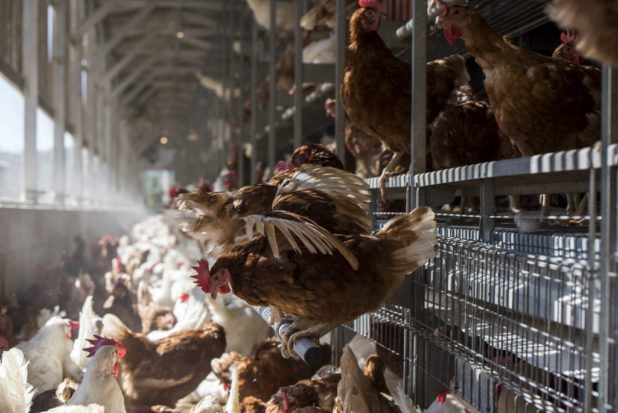
While a cage-free setting is by no means an ideal environment, it is a much better alternative to a battery cage. Photo by David Paul Morris
New federal data released this month shows the enormous progress we have made toward the goal of ending the cruel cage confinement of farm animals in the United States. More than a quarter (26.2%) of eggs produced in our nation are now cage-free, according to official numbers published by the U.S. Department of Agriculture. That represents 86.5 million hens alive today who are being spared the horrors of being immobilized inside battery cages, and it’s a milestone worthy of celebration.
About 15 years ago when the Humane Society of the United States made ending cage confinement a top priority, only about 3% of the egg industry was cage-free. Working alongside other terrific animal protection groups and grassroots advocates nationwide, we launched legislative and corporate campaigns, persuading food corporations, producers and lawmakers to embrace standards that are better for hens.
More than 200 companies have since pledged to source eggs from cage-free hens (and we’re pushing these companies now to fulfill those pledges.) We also led political campaigns in five states—Michigan, California, Oregon, Washington, and Massachusetts—to ban the caging of hens and mandate that all eggs sold in these states be cage-free. Similar bills are pending in other states, and we successfully lobbied in Rhode Island to ban the use of cages within the state.
Our strategy has involved educating consumers about the tremendous suffering of farm animals, which has substantially strengthened demand for cage-free eggs. With hundreds of millions of egg-laying hens trapped in the U.S. food system at any given time, it is easy to lose sight of the suffering of individual animals. But every chicken has the capacity to suffer and feel pain, and a slew of reports and studies over the past decade show these birds are much smarter than they’re typically given credit for. As Humane Society International’s senior scientist Dr. Sara Shields and other experts explained in an All Animals article, chickens have complex communication systems, teach their young, and can even do basic math.
Imagine, then, the suffering these animals endure in a typical egg facility, where each hen is locked inside a barren wire “battery cage” with as many as 10 other birds. She has less space than the dimensions of an iPad on which to live her entire life, and not enough room to even extend her wings. This life of frustration and deprivation continues for almost two years until her egg production declines and she’s killed.
While a cage-free setting is by no means an ideal environment, it is a much better alternative to a battery cage. The standards we push for require that cage-free facilities give hens more than twice as much space per bird compared to what’s allotted in a battery cage. Typically they’re able to walk through the entire barn. In addition, the birds must be provided with enrichments that are vital to their natural behaviors, such as nest boxes, perches, as well as dust-bathing and scratching areas.
Our work continues at full speed even in these challenging times. Join us today in celebrating this important milestone for egg-laying hens. You have our assurance that we will not rest until the day when not a single farm animal is forced to endure life inside a cruel cage.
The post More than 86 million egg-laying hens in the U.S. are now cage-free appeared first on A Humane World.
Enviroshop is maintained by dedicated NetSys Interactive Inc. owners & employees who generously contribute their time to maintenance & editing, web design, custom programming, & website hosting for Enviroshop.
